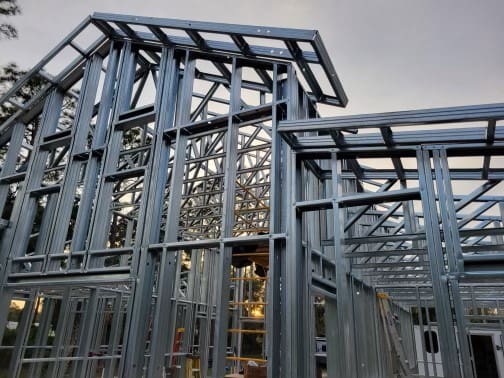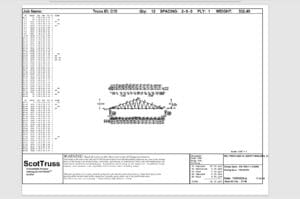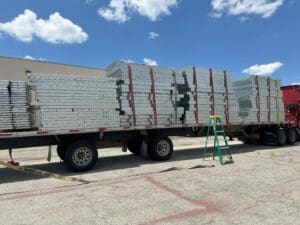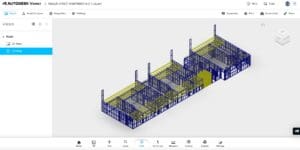
Steel Building Information
Steel structures are commonly called pre-fabricated or pre-engineered steel due to the detail you get into at design stage. The strength & versatility of steel make it the number-one choice for most applications, including garages, shops, agricultural storage, churches, aircraft hangars, homes, recreational centers, arenas, and commercial and industrial projects. The current steel building offering is nothing like the past. With the right package, you can make the exterior look like any wood-built structure you have seen and maintain the benefits of steel.
Steel buildings are environmentally friendly, with many companies using only recycled steel. This allows you to go green without giving up appearance or convenience. A 2,000-square-foot building requires approximately 40–50 trees to build, versus the same-size steel building, which requires about six scrap automobiles.
If preferred, exterior appearances can easily be adapted to using stone, brick, stucco, or other common materials.
With a low initial cost and almost no maintenance cost, steel buildings are buildings of the future for the smart consumer.
Using ABP Light Gauge Steel SYSTEM AND YOUR PROCESS
-
High strength results in safer structures, less maintenance and slower aging of structure
- Fire safety
- Not vulnerable to termites
- No additional preservative chemicals are required over and above the galvanising process to treat steel, unlike the treatment of timber
- Not vulnerable to any type of fungi or organism
- Less probability of foundation problems - 5 times lighter than wood which results in less movement
- Less probability of damage in an earthquake - lighter structure with stronger connections results in less seismic force
- Less probability of damage in high winds - stronger connections, rivetted and screwed versus nailed
- Lighter than other framing materials - no lifting equipment required on site. One person can easily carry a 5-metre fabricated panel
- Easy material selection - no need to cull or sort
- Straight walls and Square corners
- Calls backs due to cracks are eliminated
- Windows and doors open and close as they should
- Less scrap and waste (2% for steel vs. 20% for timber)
- Environmental selling and green positioning
- Consumer perceives steel as better
- No drying out period in wet weather, resulting in no delays
- Building with prefabricated steel reduces on-site construction activity, which in turn lessens risks to labor teams and helps ensure a high-quality final product. The ease of assembly with cold formed steel framing helps eliminate the chances of injuries or even fatalities among onsite workers.
- Steel is 100 percent recyclable. Each year, nearly 68.7 percent of all steel scrap is North America is recycled (Source: Steel Recycling Institute)
- Steel does not contribute to the growth of landfills. (Source: Steel Framing Alliance)
- Steel framed structures stay straight and true and do not expand and contract with humidity and temperature changes. This means that door and windows openings framed with steel remain stable and this saves on energy costs. (Source: Steel Framing Alliance)
- Cold-formed steel has the highest strength-to-weight-ratio of any structural building material. As a result steel projects can be built with fewer materials (Source: Steel Framing Alliance).
- Highest strength-to-weight ratio of any building material
- 100% recyclable
- Non-combustible - does not burn and will not contribute fuel to the spread of a fire
- Inorganic - will not rot, warp, split, crack or creep
- Dimensionally stable - does not expand or contract with moisture content
- Consistent material quality - produced in strict accordance with national standards, no regional variations
- ABP's panelised fabrication system allows high speed manufacture for large scale projects and for transportable and modular houses assembled in a factory environment.
- ABP's light gauge steel products are a well proven offsite/onsite manufacturing when logistics are a challenge or large scale production is required.
- Local engineering functionality is built into the software,
whether for single story structures with conventional
trusses, or multi-level buildings with complex roofs. - The powerful truss engineering capability provides
complete structural analysis and design of trusses. - Optimizing trusses with economical steel usage without
compromising local engineering requirements. - Trusses can be engineered for all conditions: non-cyclonic
to extreme cyclonic in excess of 300 km/h (200 mph). - Virtually any shaped truss can be produced including
coffered ceilings, parallel cord trusses, curved trusses, dual
pitched roof trusses and much more. - Interactive analysis converts frames into engineering
geometry for linear static Finite Element (FE) analysis
with user defined loads and boundary conditions.


Once your building project has permits and you're ready to build ABP will arrange to co-ordinate the fabrication in line with your desired build schedule.
Once your materials are completed, using your detailed packing list they are safely bundled and loaded onto flatbed trailers or containers if needed. A 2-man crew can unload the materials and restack at site to prepare for you for construction.

ABP provides a link to your 3D steel building's design model so that you may share the link with your sub-contractors, this allows them a clear view of what is required from their trade in conjunction with the steel structure. The time and cost savings from using this feature with your subs!!

Our design software offers an advanced, comprehensive solution for the design of light gauge steel framing structures to accommodate any architectural design including curved roof trusses.
It’s powerful, intuitive and reduces multi-step processes into a single integrated solution making it easy to use and share with your subs for residential and light commercial construction. This allows for rapid "building design to production time"

